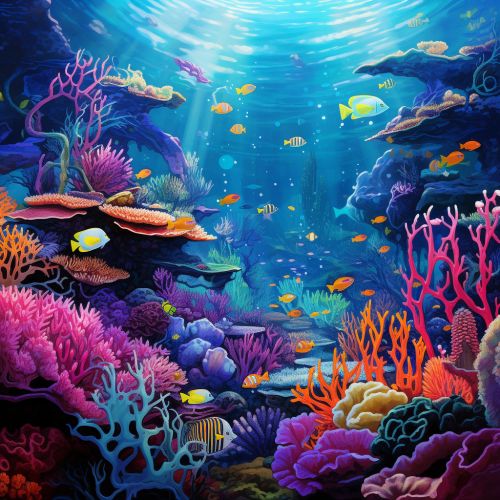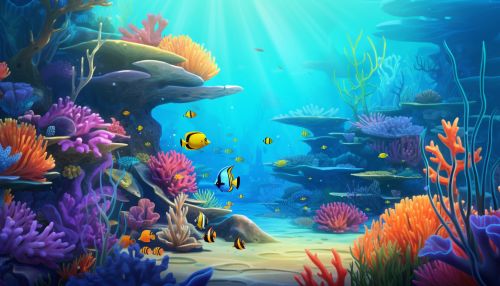Marine Biogeochemical Cycles
Introduction
Marine biogeochemical cycles are integral components of the earth's climate system, influencing the planet's temperature, atmospheric composition, and overall climate stability. These cycles involve the transformation and cycling of chemical substances among the biosphere, atmosphere, hydrosphere, and geosphere within the marine environment.


Primary Marine Biogeochemical Cycles
The primary marine biogeochemical cycles include the carbon cycle, nitrogen cycle, phosphorus cycle, and sulfur cycle. These cycles are interconnected, with changes in one cycle often impacting the others.
Carbon Cycle
The marine carbon cycle is a complex process involving the exchange of carbon between the ocean, atmosphere, and marine life. Carbon dioxide (CO2) from the atmosphere dissolves into the ocean where it is used by phytoplankton during photosynthesis. The carbon is then transferred through the food chain as organisms consume one another. When marine organisms die, their bodies sink to the seafloor, where they decompose and release the carbon back into the water or become part of the sediment.
Nitrogen Cycle
The marine nitrogen cycle involves the transformation of nitrogen gas (N2) from the atmosphere into various forms that can be utilized by marine organisms. Key processes in this cycle include nitrogen fixation, nitrification, and denitrification. Nitrogen fixation is the process by which certain bacteria convert atmospheric nitrogen into ammonia (NH3), which can be used by plants. Nitrification is the conversion of ammonia to nitrite (NO2-) and then to nitrate (NO3-), which are forms of nitrogen that can be used by many marine organisms. Denitrification is the process by which nitrate is converted back into nitrogen gas, which is released back into the atmosphere.
Phosphorus Cycle
The marine phosphorus cycle involves the movement of phosphorus through the marine ecosystem. Phosphorus is a key nutrient for marine organisms, playing a critical role in energy transfer and storage, as well as in the formation of DNA and cell membranes. The primary source of phosphorus in the ocean is from weathering of rocks on land, which is carried to the ocean by rivers. In the ocean, phosphorus is taken up by phytoplankton and passed through the food chain. When organisms die, the phosphorus is released back into the water or becomes part of the sediment.
Sulfur Cycle
The marine sulfur cycle involves the transformation of sulfur compounds in the ocean. Sulfur is an essential nutrient for many marine organisms and plays a key role in the formation of proteins and vitamins. The sulfur cycle is closely linked with the carbon cycle, as many sulfur compounds are produced or consumed during the decomposition of organic matter.
Impacts of Human Activities on Marine Biogeochemical Cycles
Human activities, such as burning of fossil fuels, deforestation, and industrial processes, have significantly altered marine biogeochemical cycles. These alterations have led to changes in the chemical composition of the ocean, including ocean acidification, eutrophication, and changes in nutrient availability.
Ocean Acidification
Ocean acidification is a direct result of increased carbon dioxide emissions from human activities. As more CO2 is absorbed by the ocean, it reacts with seawater to form carbonic acid, which lowers the pH of the ocean, making it more acidic. This can have detrimental effects on marine organisms, particularly those that build shells or skeletons out of calcium carbonate, such as corals and shellfish.
Eutrophication
Eutrophication is the process by which excessive nutrients, particularly nitrogen and phosphorus, enter the ocean, leading to an overgrowth of algae. This can result in harmful algal blooms, which can deplete oxygen levels in the water and lead to the death of marine life. Eutrophication is primarily caused by agricultural runoff and sewage discharge.
Changes in Nutrient Availability
Human activities have also altered the availability of nutrients in the ocean. For example, the burning of fossil fuels releases sulfur and nitrogen into the atmosphere, which can be deposited into the ocean, altering the sulfur and nitrogen cycles. Additionally, deforestation and land use changes can increase the amount of phosphorus and other nutrients entering the ocean, impacting the phosphorus cycle.
Conclusion
Marine biogeochemical cycles play a crucial role in maintaining the health and stability of the earth's climate system. Understanding these cycles and the impacts of human activities on them is essential for predicting future climate change and developing strategies for mitigating these impacts.
